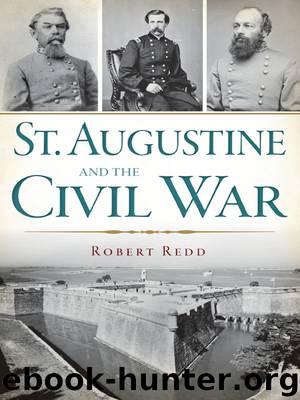St. Augustine and the Civil War by Robert Redd

Author:Robert Redd
Language: eng
Format: epub
Publisher: Arcadia Publishing Inc.
Published: 2014-03-21T16:00:00+00:00
THE SLAVE MARKET
Little is known about the overall slave trade in St. Augustine. Despite being a port city, it appears that St. Augustine was not a major area where slaves were imported and sold prior to the banning of the slave trade in 1808. This could partly be due to the dangerous conditions offshore and the associated difficulty of getting a ship to harbor but is most likely due to the lack of population and wealth in the area. Despite not being able to import slaves, the internal slave trade continued to grow and was a source of wealth for many. Florida, with a comparatively small population and overall lack of assets, does not appear to have widely participated in comparison to its cotton-producing sister states.
When one thinks of slave markets, the mind is immediately drawn to cities such as New Orleans and Charleston. These cities were known for their large public auctions where men, women and children were herded like cattle, stuffed in holding pens and then paraded before potential bidders. In many instances, families were broken apart with little to no concern for the welfare of children or the sanctity of marriage. Those slaves who were young, well behaved and of good health often brought the most money. While having a skill could be important, most buyers were looking for field hands who could bring in more revenue than it cost to maintain them.
Located in the Plaza is an open-air building known by the name Public Market or sometimes by the fancifully titled Slave Market. There is little evidence showing that the building was a slave market in the sense that we think of that term today. The moniker “Slave Market” appears to have come into being after the Civil War. Perhaps the earliest printed record comes from regional promoter Max Bloomfield:
East of the Confederate monument stands the old, old market. A queer-looking structure it is. ’Tis hard to name its style of architecture, therefore we will call it a piece of Augustinian mechanism. Four years ago it was used as a meat market, but since, the Council and a private gentleman have rescued it from what must have been degrading to this proud piece of Spanish antiquity, of which very little is known. We have been told that before the war it was used as a slave market. Whenever a sale was to take place the bell in the cupola would be rung to notify the public. The reader will please understand that the compiler of this Guide does not hold himself responsible for the slave-market story, but, in the words of the old sergeant at the fort, will say: “I’m only giving it to ye as it was given to me, d’ye moind now?”93
From the same period, the English author Lady Mary Anne Duffus Hardy wrote of her travels in the South:
There is the “Plaza de la Constitution,” where the good Christians burnt their bretheren a century ago; it is a large square, laid out with
Download
This site does not store any files on its server. We only index and link to content provided by other sites. Please contact the content providers to delete copyright contents if any and email us, we'll remove relevant links or contents immediately.
Tiger I and Tiger II (Images of War) by Anthony Tucker-Jones(842)
Smithsonian Civil War by Smithsonian Institution(791)
Battle Cry of Freedom by James M. McPherson(757)
The Pacific War by Robert O'Neill(656)
Deadliest Men by Kirchner Paul(636)
Maps of War by Jeremy Black(628)
Flags of Our Fathers by James Bradley & Ron Powers(623)
D-Day, June 6, 1944: The Climactic Battle of World War II by Stephen E. Ambrose(588)
Third Reich Propaganda (The Third Reich From Original Sources) by Carruthers Bob(574)
Lewes and Evesham 1264-65 by Richard Brooks(569)
The Oxford Illustrated History of the First World War by Hew Strachan(525)
The French Army in the First World War by Ian Sumner(510)
Early Samurai AD 200-1500 by Anthony J Bryant(459)
Battle Cry of Freedom: The Civil War Era (Oxford History of the United States) by McPherson James M(450)
American Amphibious Gunboats in World War II by Robin L. Rielly(435)
Kursk 1943 by Robert Forczyk(427)
World War II River Assault Tactics by Gordon Rottman(427)
Frames of War by Judith Butler(419)
The Civil War by Geoffrey C. Ward(414)
